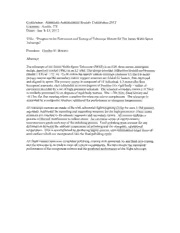
NASA Technical Reports Server (NTRS) 20120007852: Progress in the Fabrication and Testing of Telescope Mirrors for the James Webb Space Telescope PDF
Preview NASA Technical Reports Server (NTRS) 20120007852: Progress in the Fabrication and Testing of Telescope Mirrors for the James Webb Space Telescope
Conference: American Astronomical Society Conference 2012 Location: Austin, TX Dates: Jan. 8-12, 2012 Title: "Progress in the Fabrication and Testing of Telescope Mirrors for The James Webb Space Telescope" Presenter: Charles W. Bowers Abstract: The telescope of the James Webb Space Telescope (JWST) is an f/20, three mirror anastigmat design, passively cooled (40K) in an L2 orbit. The design provides diffraction limited performance (Strehl ~ 0.8) at .=2 m. To fit within the launch vehicle envelope (Arianne V), the 6.6 meter primary mirror and the secondary mirror support structure are folded for launch, then deployed and aligned in space. The primary mirror is composed of 18 individual, 1.3 meter (flat flat) hexagonal segments, each adjustable in seven degrees of freedom (six rigid body + radius of curvature) provided by a set of high precision actuators. The actuated secondary mirror (~0.74m) is similarly positioned in six degrees of rigid body motion. The ~.70x.51m, fixed tertiary and ~0.17m, flat fine steering mirror complete the telescope mirror complement. The telescope is supported by a composite structure optimized for performance at cryogenic temperatures. All telescope mirrors are made of Be with substantiallightweighting (21 kg for each 1.3M primary segment). Additional Be mounting and supporting structure for the high precision (~10nm steps) actuators are attached to the primary segments and secondary mirror. All mirrors undergo a process of thermal stabilization to reduce stress. An extensive series of interferometric measurements guide each step of the polishing process. Final polishing must account for any deformation between the ambient temperature of polishing and the cryogenic, operational temperature. This is accomplished by producing highly precise, cryo deformation target maps of each surface which are incorporated into the final polishing cycle. All flight mirrors have now completed polishing, coating with protected Au and final cryo testing, and the telescope is on track to meet all system requirements. We here review the measured performance of the component mirrors and the predicted performance of the flight telescope.
